CHCECE009: EYLF, NQF, and National Regulations in Early Childhood
VerifiedAdded on 2023/06/12
|15
|4137
|322
Report
AI Summary
This assignment solution provides a comprehensive examination of the Early Years Learning Framework (EYLF) within the context of the National Quality Standards (NQF) and the Education and Care Services National Regulations 2011. It outlines children's learning, discusses the United Nations Convention on the Rights of the Child, and identifies different roles within an early childhood service. The report also lists and describes national approved learning frameworks, highlighting the principles and practices in children's learning and early development, defining pedagogy and intentional teaching, and examining reflective practices for educators. It delves into assessment and planning policies, linking them to the EYLF and NQS, and emphasizes the importance of play-based learning and educator responsibilities in creating a supportive and high-quality learning environment.
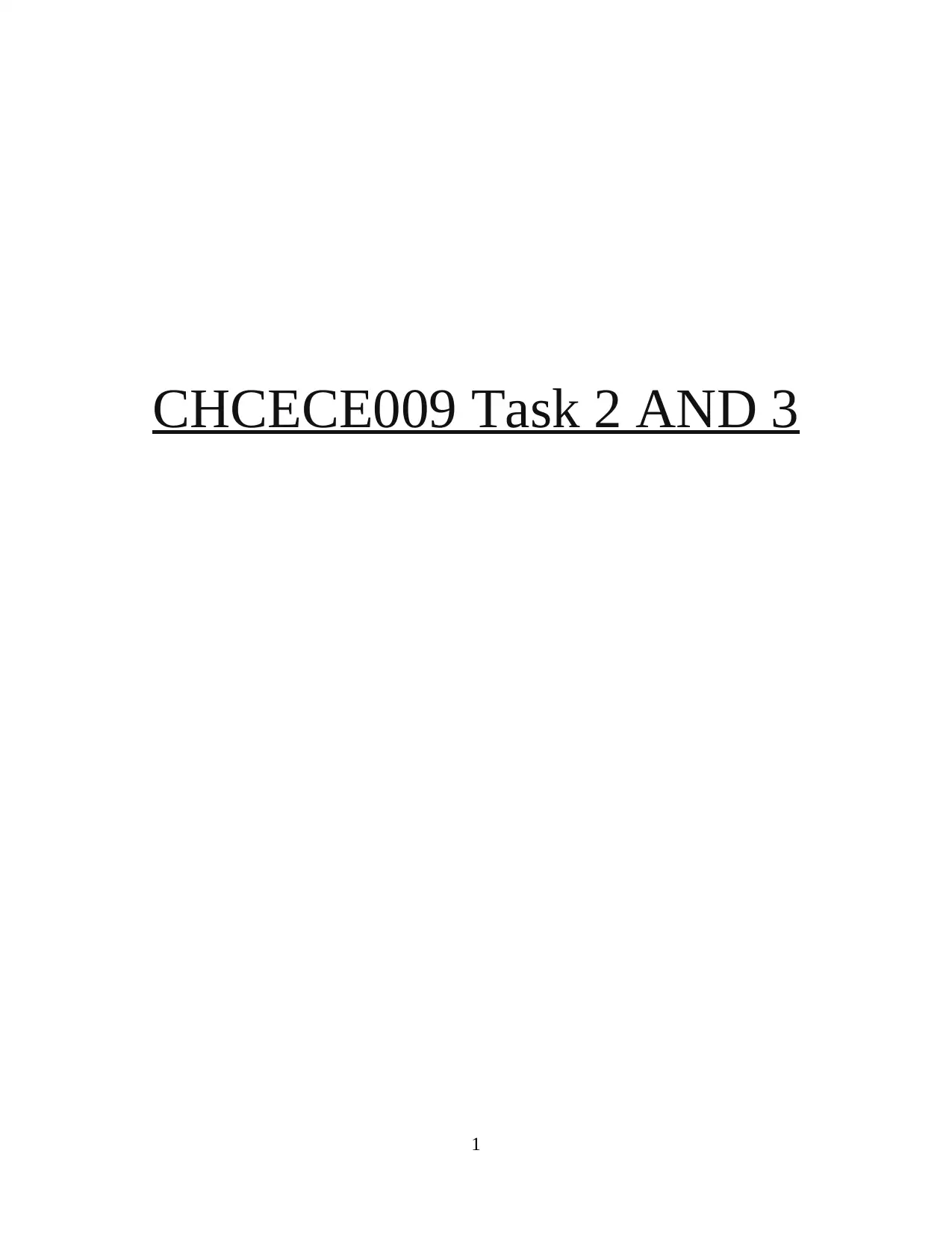
CHCECE009 Task 2 AND 3
1
1
Paraphrase This Document
Need a fresh take? Get an instant paraphrase of this document with our AI Paraphraser
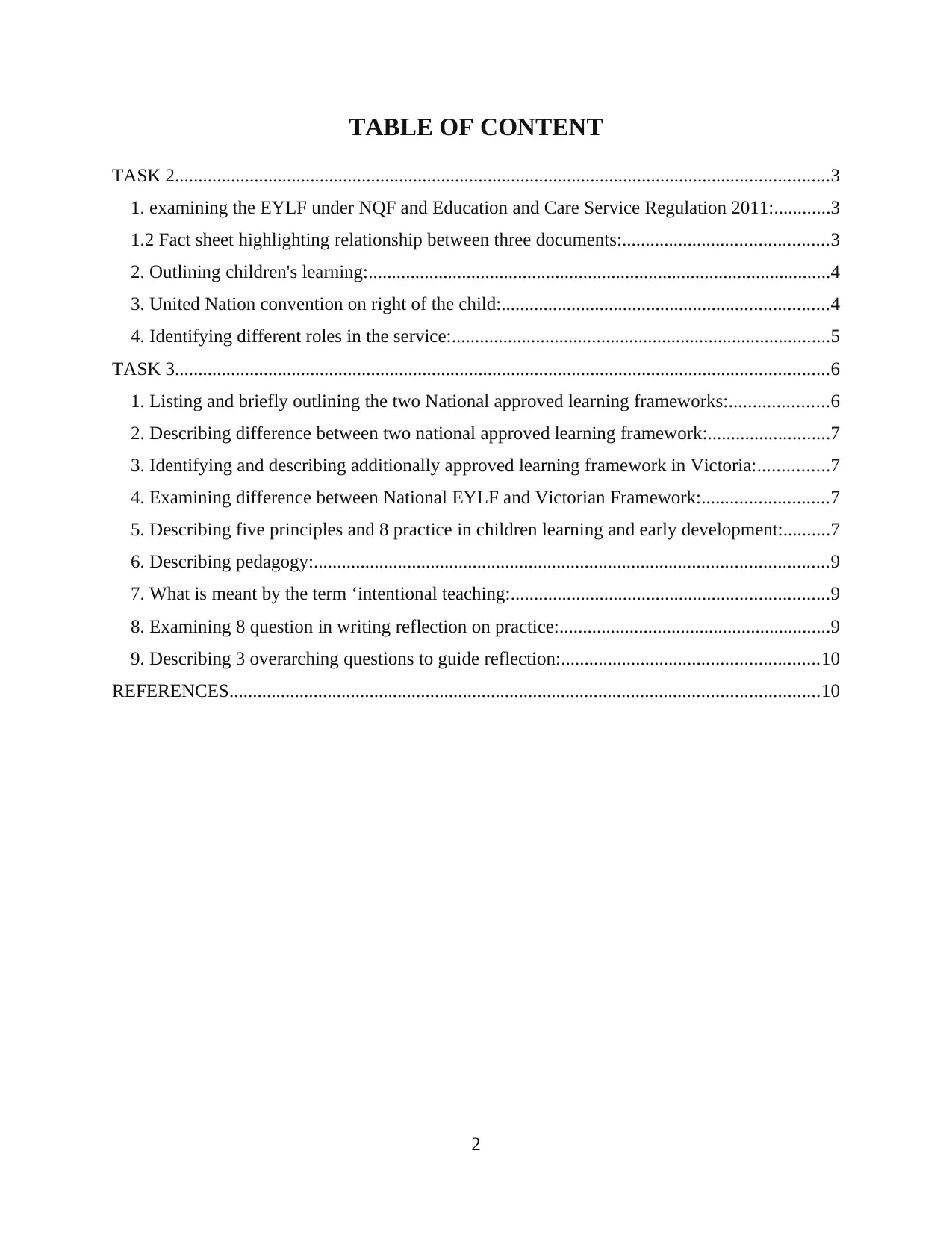
TABLE OF CONTENT
TASK 2............................................................................................................................................3
1. examining the EYLF under NQF and Education and Care Service Regulation 2011:............3
1.2 Fact sheet highlighting relationship between three documents:............................................3
2. Outlining children's learning:...................................................................................................4
3. United Nation convention on right of the child:......................................................................4
4. Identifying different roles in the service:.................................................................................5
TASK 3............................................................................................................................................6
1. Listing and briefly outlining the two National approved learning frameworks:.....................6
2. Describing difference between two national approved learning framework:..........................7
3. Identifying and describing additionally approved learning framework in Victoria:...............7
4. Examining difference between National EYLF and Victorian Framework:...........................7
5. Describing five principles and 8 practice in children learning and early development:..........7
6. Describing pedagogy:..............................................................................................................9
7. What is meant by the term ‘intentional teaching:....................................................................9
8. Examining 8 question in writing reflection on practice:..........................................................9
9. Describing 3 overarching questions to guide reflection:.......................................................10
REFERENCES..............................................................................................................................10
2
TASK 2............................................................................................................................................3
1. examining the EYLF under NQF and Education and Care Service Regulation 2011:............3
1.2 Fact sheet highlighting relationship between three documents:............................................3
2. Outlining children's learning:...................................................................................................4
3. United Nation convention on right of the child:......................................................................4
4. Identifying different roles in the service:.................................................................................5
TASK 3............................................................................................................................................6
1. Listing and briefly outlining the two National approved learning frameworks:.....................6
2. Describing difference between two national approved learning framework:..........................7
3. Identifying and describing additionally approved learning framework in Victoria:...............7
4. Examining difference between National EYLF and Victorian Framework:...........................7
5. Describing five principles and 8 practice in children learning and early development:..........7
6. Describing pedagogy:..............................................................................................................9
7. What is meant by the term ‘intentional teaching:....................................................................9
8. Examining 8 question in writing reflection on practice:..........................................................9
9. Describing 3 overarching questions to guide reflection:.......................................................10
REFERENCES..............................................................................................................................10
2
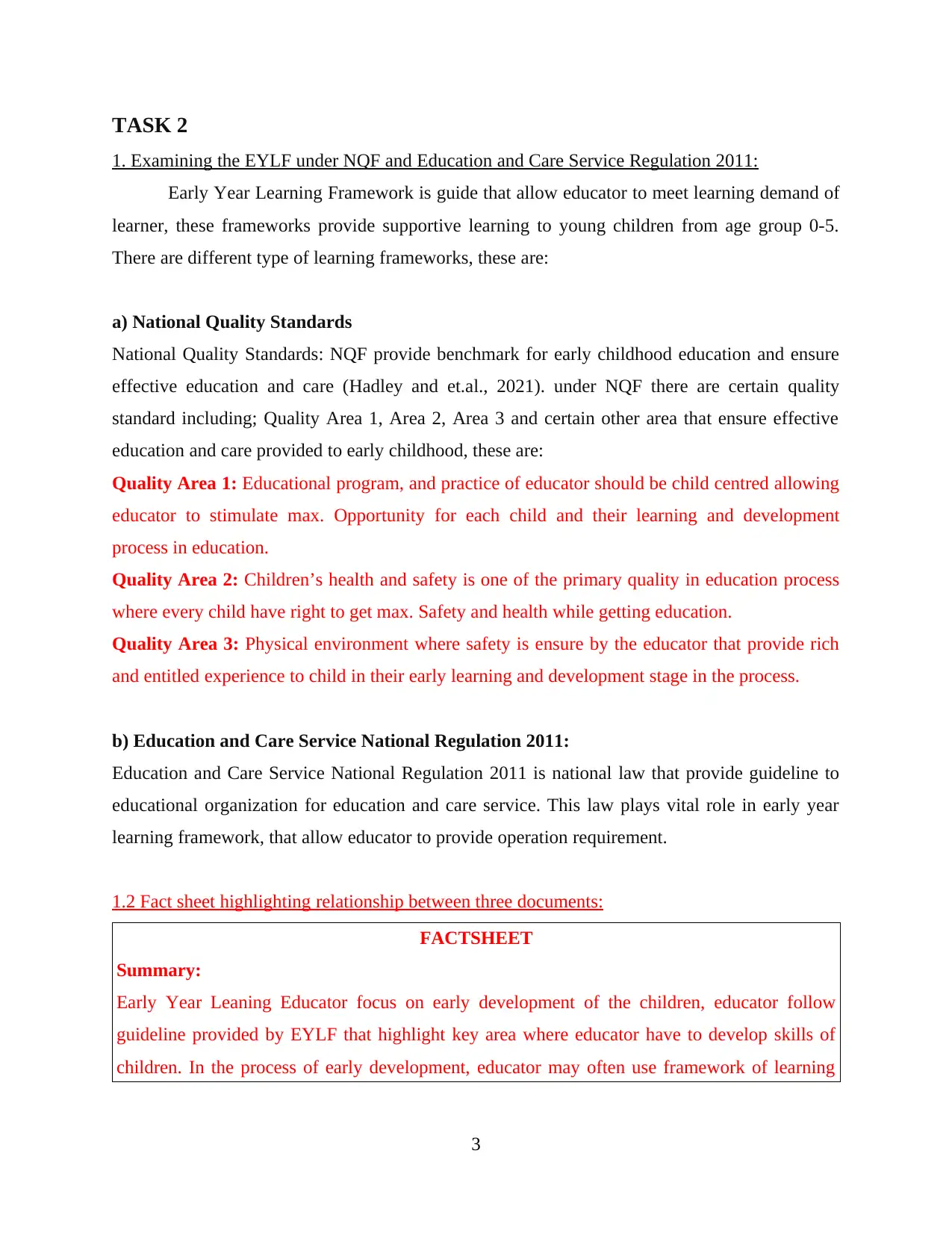
TASK 2
1. Examining the EYLF under NQF and Education and Care Service Regulation 2011:
Early Year Learning Framework is guide that allow educator to meet learning demand of
learner, these frameworks provide supportive learning to young children from age group 0-5.
There are different type of learning frameworks, these are:
a) National Quality Standards
National Quality Standards: NQF provide benchmark for early childhood education and ensure
effective education and care (Hadley and et.al., 2021). under NQF there are certain quality
standard including; Quality Area 1, Area 2, Area 3 and certain other area that ensure effective
education and care provided to early childhood, these are:
Quality Area 1: Educational program, and practice of educator should be child centred allowing
educator to stimulate max. Opportunity for each child and their learning and development
process in education.
Quality Area 2: Children’s health and safety is one of the primary quality in education process
where every child have right to get max. Safety and health while getting education.
Quality Area 3: Physical environment where safety is ensure by the educator that provide rich
and entitled experience to child in their early learning and development stage in the process.
b) Education and Care Service National Regulation 2011:
Education and Care Service National Regulation 2011 is national law that provide guideline to
educational organization for education and care service. This law plays vital role in early year
learning framework, that allow educator to provide operation requirement.
1.2 Fact sheet highlighting relationship between three documents:
FACTSHEET
Summary:
Early Year Leaning Educator focus on early development of the children, educator follow
guideline provided by EYLF that highlight key area where educator have to develop skills of
children. In the process of early development, educator may often use framework of learning
3
1. Examining the EYLF under NQF and Education and Care Service Regulation 2011:
Early Year Learning Framework is guide that allow educator to meet learning demand of
learner, these frameworks provide supportive learning to young children from age group 0-5.
There are different type of learning frameworks, these are:
a) National Quality Standards
National Quality Standards: NQF provide benchmark for early childhood education and ensure
effective education and care (Hadley and et.al., 2021). under NQF there are certain quality
standard including; Quality Area 1, Area 2, Area 3 and certain other area that ensure effective
education and care provided to early childhood, these are:
Quality Area 1: Educational program, and practice of educator should be child centred allowing
educator to stimulate max. Opportunity for each child and their learning and development
process in education.
Quality Area 2: Children’s health and safety is one of the primary quality in education process
where every child have right to get max. Safety and health while getting education.
Quality Area 3: Physical environment where safety is ensure by the educator that provide rich
and entitled experience to child in their early learning and development stage in the process.
b) Education and Care Service National Regulation 2011:
Education and Care Service National Regulation 2011 is national law that provide guideline to
educational organization for education and care service. This law plays vital role in early year
learning framework, that allow educator to provide operation requirement.
1.2 Fact sheet highlighting relationship between three documents:
FACTSHEET
Summary:
Early Year Leaning Educator focus on early development of the children, educator follow
guideline provided by EYLF that highlight key area where educator have to develop skills of
children. In the process of early development, educator may often use framework of learning
3
⊘ This is a preview!⊘
Do you want full access?
Subscribe today to unlock all pages.

Trusted by 1+ million students worldwide
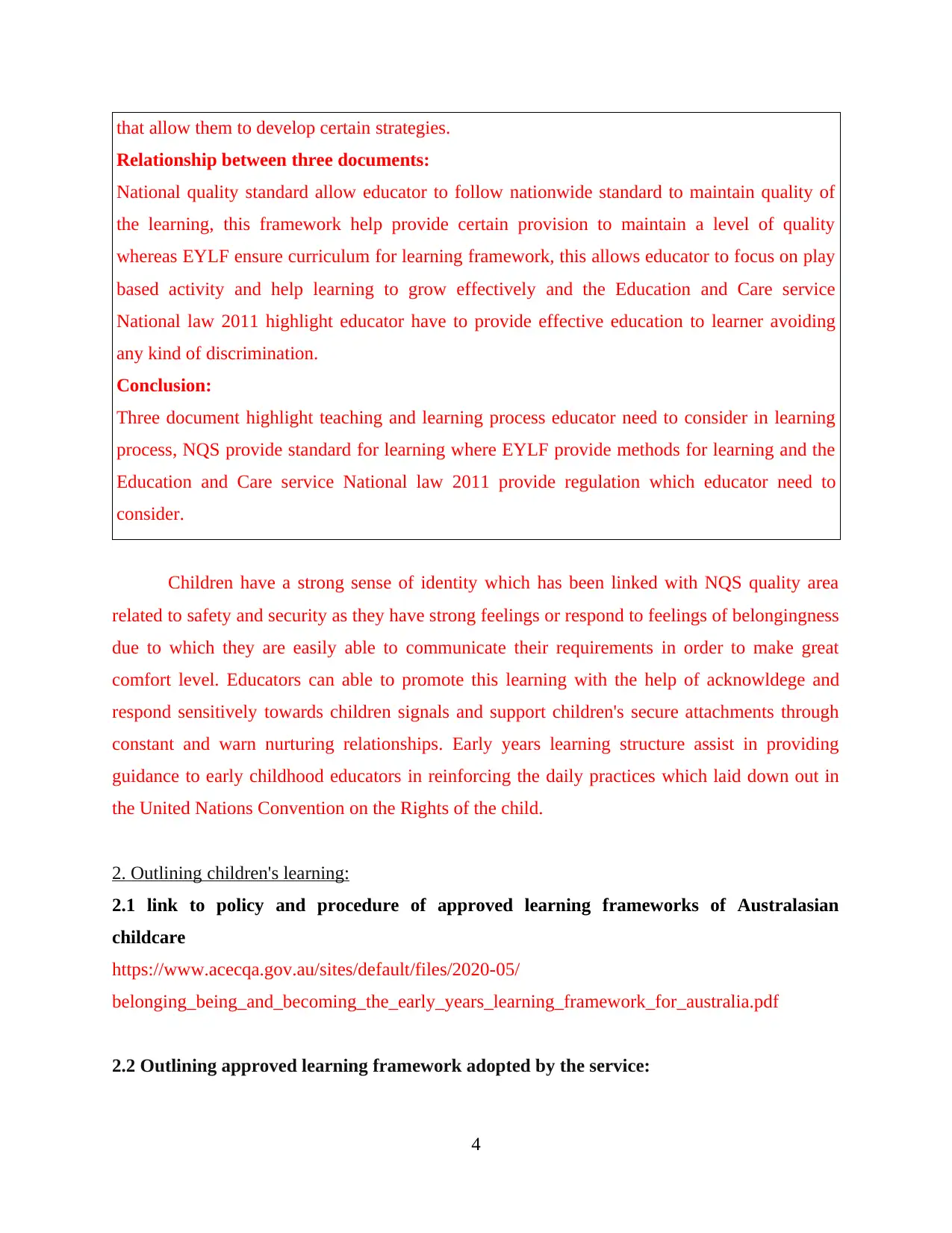
that allow them to develop certain strategies.
Relationship between three documents:
National quality standard allow educator to follow nationwide standard to maintain quality of
the learning, this framework help provide certain provision to maintain a level of quality
whereas EYLF ensure curriculum for learning framework, this allows educator to focus on play
based activity and help learning to grow effectively and the Education and Care service
National law 2011 highlight educator have to provide effective education to learner avoiding
any kind of discrimination.
Conclusion:
Three document highlight teaching and learning process educator need to consider in learning
process, NQS provide standard for learning where EYLF provide methods for learning and the
Education and Care service National law 2011 provide regulation which educator need to
consider.
Children have a strong sense of identity which has been linked with NQS quality area
related to safety and security as they have strong feelings or respond to feelings of belongingness
due to which they are easily able to communicate their requirements in order to make great
comfort level. Educators can able to promote this learning with the help of acknowldege and
respond sensitively towards children signals and support children's secure attachments through
constant and warn nurturing relationships. Early years learning structure assist in providing
guidance to early childhood educators in reinforcing the daily practices which laid down out in
the United Nations Convention on the Rights of the child.
2. Outlining children's learning:
2.1 link to policy and procedure of approved learning frameworks of Australasian
childcare
https://www.acecqa.gov.au/sites/default/files/2020-05/
belonging_being_and_becoming_the_early_years_learning_framework_for_australia.pdf
2.2 Outlining approved learning framework adopted by the service:
4
Relationship between three documents:
National quality standard allow educator to follow nationwide standard to maintain quality of
the learning, this framework help provide certain provision to maintain a level of quality
whereas EYLF ensure curriculum for learning framework, this allows educator to focus on play
based activity and help learning to grow effectively and the Education and Care service
National law 2011 highlight educator have to provide effective education to learner avoiding
any kind of discrimination.
Conclusion:
Three document highlight teaching and learning process educator need to consider in learning
process, NQS provide standard for learning where EYLF provide methods for learning and the
Education and Care service National law 2011 provide regulation which educator need to
consider.
Children have a strong sense of identity which has been linked with NQS quality area
related to safety and security as they have strong feelings or respond to feelings of belongingness
due to which they are easily able to communicate their requirements in order to make great
comfort level. Educators can able to promote this learning with the help of acknowldege and
respond sensitively towards children signals and support children's secure attachments through
constant and warn nurturing relationships. Early years learning structure assist in providing
guidance to early childhood educators in reinforcing the daily practices which laid down out in
the United Nations Convention on the Rights of the child.
2. Outlining children's learning:
2.1 link to policy and procedure of approved learning frameworks of Australasian
childcare
https://www.acecqa.gov.au/sites/default/files/2020-05/
belonging_being_and_becoming_the_early_years_learning_framework_for_australia.pdf
2.2 Outlining approved learning framework adopted by the service:
4
Paraphrase This Document
Need a fresh take? Get an instant paraphrase of this document with our AI Paraphraser
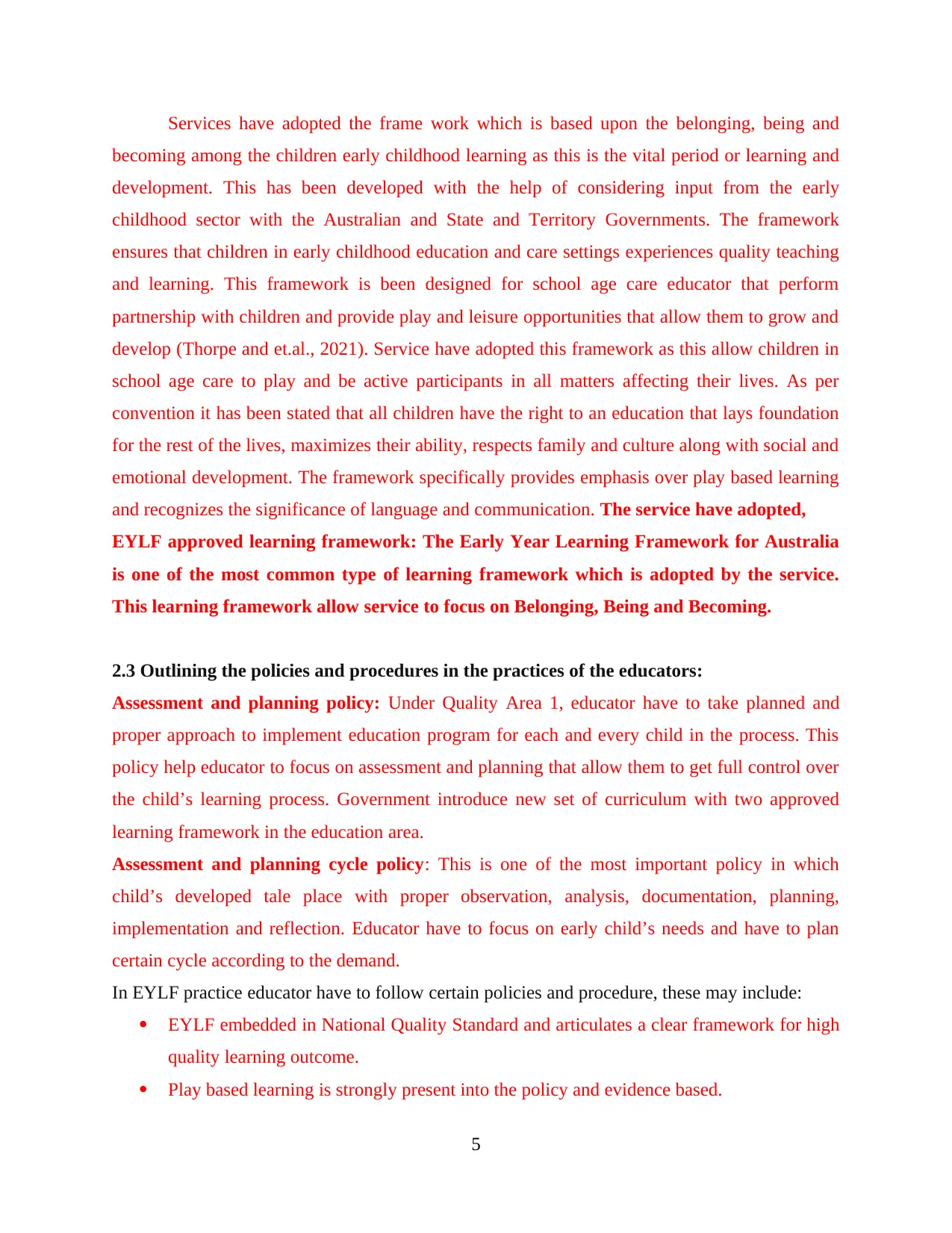
Services have adopted the frame work which is based upon the belonging, being and
becoming among the children early childhood learning as this is the vital period or learning and
development. This has been developed with the help of considering input from the early
childhood sector with the Australian and State and Territory Governments. The framework
ensures that children in early childhood education and care settings experiences quality teaching
and learning. This framework is been designed for school age care educator that perform
partnership with children and provide play and leisure opportunities that allow them to grow and
develop (Thorpe and et.al., 2021). Service have adopted this framework as this allow children in
school age care to play and be active participants in all matters affecting their lives. As per
convention it has been stated that all children have the right to an education that lays foundation
for the rest of the lives, maximizes their ability, respects family and culture along with social and
emotional development. The framework specifically provides emphasis over play based learning
and recognizes the significance of language and communication. The service have adopted,
EYLF approved learning framework: The Early Year Learning Framework for Australia
is one of the most common type of learning framework which is adopted by the service.
This learning framework allow service to focus on Belonging, Being and Becoming.
2.3 Outlining the policies and procedures in the practices of the educators:
Assessment and planning policy: Under Quality Area 1, educator have to take planned and
proper approach to implement education program for each and every child in the process. This
policy help educator to focus on assessment and planning that allow them to get full control over
the child’s learning process. Government introduce new set of curriculum with two approved
learning framework in the education area.
Assessment and planning cycle policy: This is one of the most important policy in which
child’s developed tale place with proper observation, analysis, documentation, planning,
implementation and reflection. Educator have to focus on early child’s needs and have to plan
certain cycle according to the demand.
In EYLF practice educator have to follow certain policies and procedure, these may include:
EYLF embedded in National Quality Standard and articulates a clear framework for high
quality learning outcome.
Play based learning is strongly present into the policy and evidence based.
5
becoming among the children early childhood learning as this is the vital period or learning and
development. This has been developed with the help of considering input from the early
childhood sector with the Australian and State and Territory Governments. The framework
ensures that children in early childhood education and care settings experiences quality teaching
and learning. This framework is been designed for school age care educator that perform
partnership with children and provide play and leisure opportunities that allow them to grow and
develop (Thorpe and et.al., 2021). Service have adopted this framework as this allow children in
school age care to play and be active participants in all matters affecting their lives. As per
convention it has been stated that all children have the right to an education that lays foundation
for the rest of the lives, maximizes their ability, respects family and culture along with social and
emotional development. The framework specifically provides emphasis over play based learning
and recognizes the significance of language and communication. The service have adopted,
EYLF approved learning framework: The Early Year Learning Framework for Australia
is one of the most common type of learning framework which is adopted by the service.
This learning framework allow service to focus on Belonging, Being and Becoming.
2.3 Outlining the policies and procedures in the practices of the educators:
Assessment and planning policy: Under Quality Area 1, educator have to take planned and
proper approach to implement education program for each and every child in the process. This
policy help educator to focus on assessment and planning that allow them to get full control over
the child’s learning process. Government introduce new set of curriculum with two approved
learning framework in the education area.
Assessment and planning cycle policy: This is one of the most important policy in which
child’s developed tale place with proper observation, analysis, documentation, planning,
implementation and reflection. Educator have to focus on early child’s needs and have to plan
certain cycle according to the demand.
In EYLF practice educator have to follow certain policies and procedure, these may include:
EYLF embedded in National Quality Standard and articulates a clear framework for high
quality learning outcome.
Play based learning is strongly present into the policy and evidence based.
5
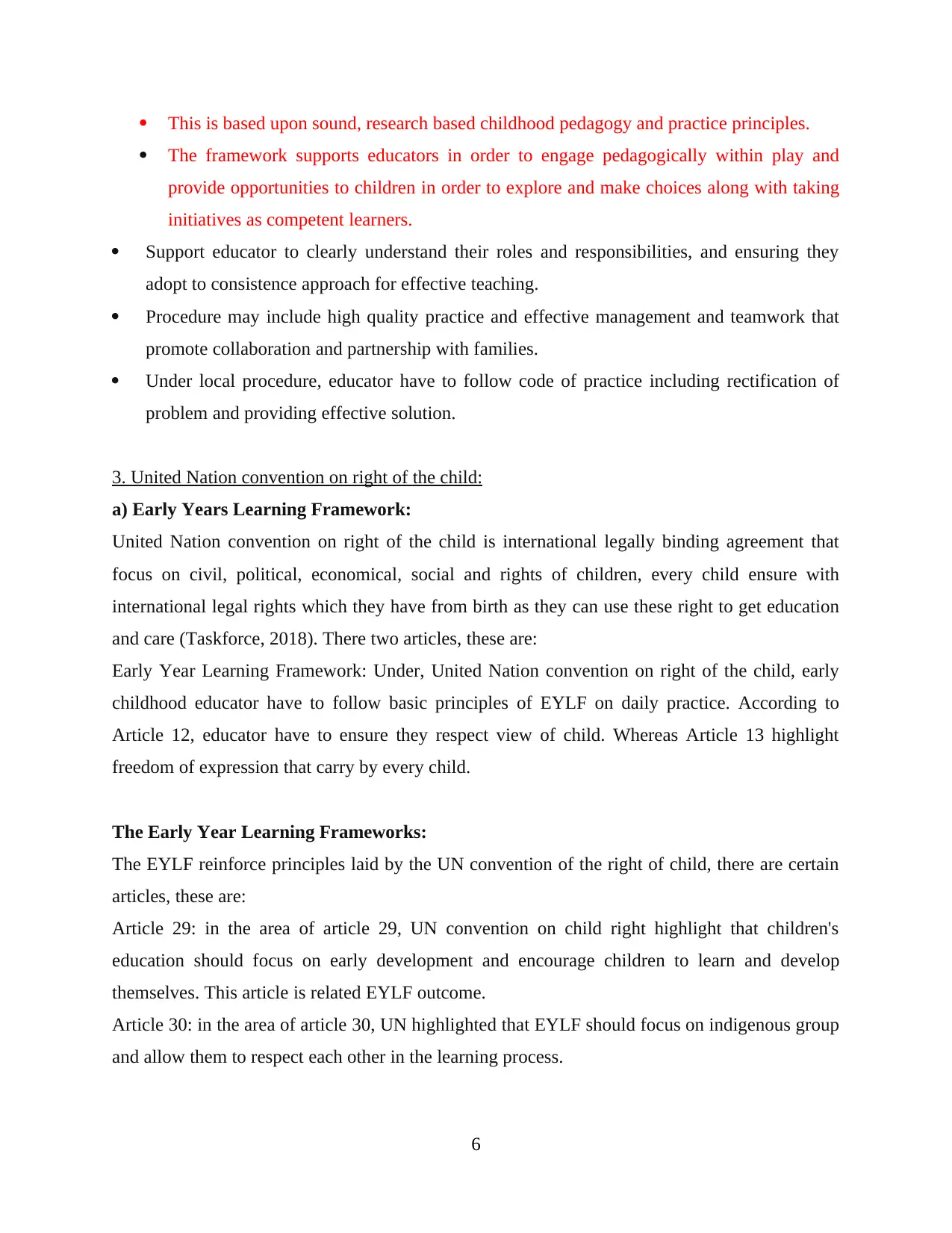
This is based upon sound, research based childhood pedagogy and practice principles.
The framework supports educators in order to engage pedagogically within play and
provide opportunities to children in order to explore and make choices along with taking
initiatives as competent learners.
Support educator to clearly understand their roles and responsibilities, and ensuring they
adopt to consistence approach for effective teaching.
Procedure may include high quality practice and effective management and teamwork that
promote collaboration and partnership with families.
Under local procedure, educator have to follow code of practice including rectification of
problem and providing effective solution.
3. United Nation convention on right of the child:
a) Early Years Learning Framework:
United Nation convention on right of the child is international legally binding agreement that
focus on civil, political, economical, social and rights of children, every child ensure with
international legal rights which they have from birth as they can use these right to get education
and care (Taskforce, 2018). There two articles, these are:
Early Year Learning Framework: Under, United Nation convention on right of the child, early
childhood educator have to follow basic principles of EYLF on daily practice. According to
Article 12, educator have to ensure they respect view of child. Whereas Article 13 highlight
freedom of expression that carry by every child.
The Early Year Learning Frameworks:
The EYLF reinforce principles laid by the UN convention of the right of child, there are certain
articles, these are:
Article 29: in the area of article 29, UN convention on child right highlight that children's
education should focus on early development and encourage children to learn and develop
themselves. This article is related EYLF outcome.
Article 30: in the area of article 30, UN highlighted that EYLF should focus on indigenous group
and allow them to respect each other in the learning process.
6
The framework supports educators in order to engage pedagogically within play and
provide opportunities to children in order to explore and make choices along with taking
initiatives as competent learners.
Support educator to clearly understand their roles and responsibilities, and ensuring they
adopt to consistence approach for effective teaching.
Procedure may include high quality practice and effective management and teamwork that
promote collaboration and partnership with families.
Under local procedure, educator have to follow code of practice including rectification of
problem and providing effective solution.
3. United Nation convention on right of the child:
a) Early Years Learning Framework:
United Nation convention on right of the child is international legally binding agreement that
focus on civil, political, economical, social and rights of children, every child ensure with
international legal rights which they have from birth as they can use these right to get education
and care (Taskforce, 2018). There two articles, these are:
Early Year Learning Framework: Under, United Nation convention on right of the child, early
childhood educator have to follow basic principles of EYLF on daily practice. According to
Article 12, educator have to ensure they respect view of child. Whereas Article 13 highlight
freedom of expression that carry by every child.
The Early Year Learning Frameworks:
The EYLF reinforce principles laid by the UN convention of the right of child, there are certain
articles, these are:
Article 29: in the area of article 29, UN convention on child right highlight that children's
education should focus on early development and encourage children to learn and develop
themselves. This article is related EYLF outcome.
Article 30: in the area of article 30, UN highlighted that EYLF should focus on indigenous group
and allow them to respect each other in the learning process.
6
⊘ This is a preview!⊘
Do you want full access?
Subscribe today to unlock all pages.

Trusted by 1+ million students worldwide
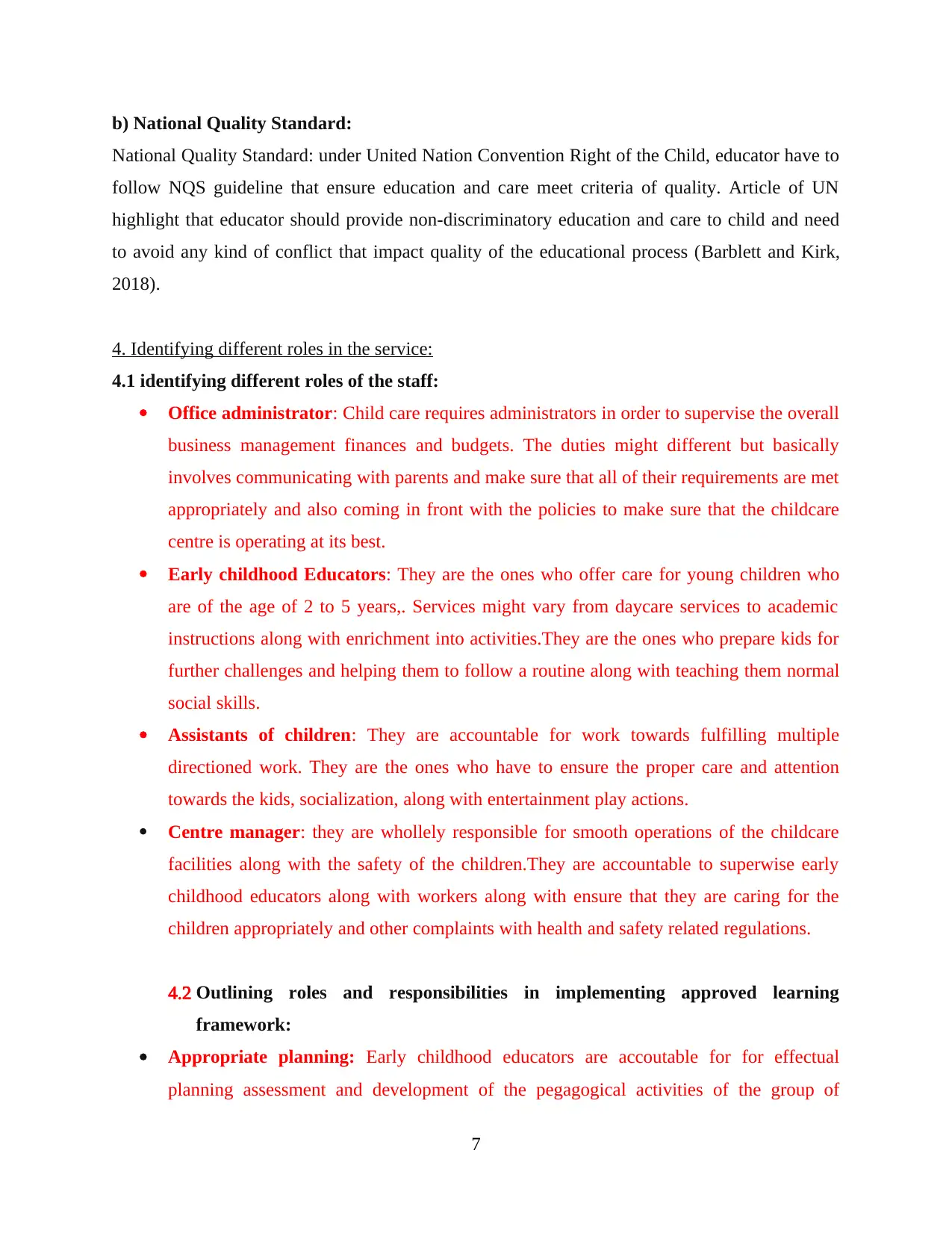
b) National Quality Standard:
National Quality Standard: under United Nation Convention Right of the Child, educator have to
follow NQS guideline that ensure education and care meet criteria of quality. Article of UN
highlight that educator should provide non-discriminatory education and care to child and need
to avoid any kind of conflict that impact quality of the educational process (Barblett and Kirk,
2018).
4. Identifying different roles in the service:
4.1 identifying different roles of the staff:
Office administrator: Child care requires administrators in order to supervise the overall
business management finances and budgets. The duties might different but basically
involves communicating with parents and make sure that all of their requirements are met
appropriately and also coming in front with the policies to make sure that the childcare
centre is operating at its best.
Early childhood Educators: They are the ones who offer care for young children who
are of the age of 2 to 5 years,. Services might vary from daycare services to academic
instructions along with enrichment into activities.They are the ones who prepare kids for
further challenges and helping them to follow a routine along with teaching them normal
social skills.
Assistants of children: They are accountable for work towards fulfilling multiple
directioned work. They are the ones who have to ensure the proper care and attention
towards the kids, socialization, along with entertainment play actions.
Centre manager: they are whollely responsible for smooth operations of the childcare
facilities along with the safety of the children.They are accountable to superwise early
childhood educators along with workers along with ensure that they are caring for the
children appropriately and other complaints with health and safety related regulations.
4.2 Outlining roles and responsibilities in implementing approved learning
framework:
Appropriate planning: Early childhood educators are accoutable for for effectual
planning assessment and development of the pegagogical activities of the group of
7
National Quality Standard: under United Nation Convention Right of the Child, educator have to
follow NQS guideline that ensure education and care meet criteria of quality. Article of UN
highlight that educator should provide non-discriminatory education and care to child and need
to avoid any kind of conflict that impact quality of the educational process (Barblett and Kirk,
2018).
4. Identifying different roles in the service:
4.1 identifying different roles of the staff:
Office administrator: Child care requires administrators in order to supervise the overall
business management finances and budgets. The duties might different but basically
involves communicating with parents and make sure that all of their requirements are met
appropriately and also coming in front with the policies to make sure that the childcare
centre is operating at its best.
Early childhood Educators: They are the ones who offer care for young children who
are of the age of 2 to 5 years,. Services might vary from daycare services to academic
instructions along with enrichment into activities.They are the ones who prepare kids for
further challenges and helping them to follow a routine along with teaching them normal
social skills.
Assistants of children: They are accountable for work towards fulfilling multiple
directioned work. They are the ones who have to ensure the proper care and attention
towards the kids, socialization, along with entertainment play actions.
Centre manager: they are whollely responsible for smooth operations of the childcare
facilities along with the safety of the children.They are accountable to superwise early
childhood educators along with workers along with ensure that they are caring for the
children appropriately and other complaints with health and safety related regulations.
4.2 Outlining roles and responsibilities in implementing approved learning
framework:
Appropriate planning: Early childhood educators are accoutable for for effectual
planning assessment and development of the pegagogical activities of the group of
7
Paraphrase This Document
Need a fresh take? Get an instant paraphrase of this document with our AI Paraphraser
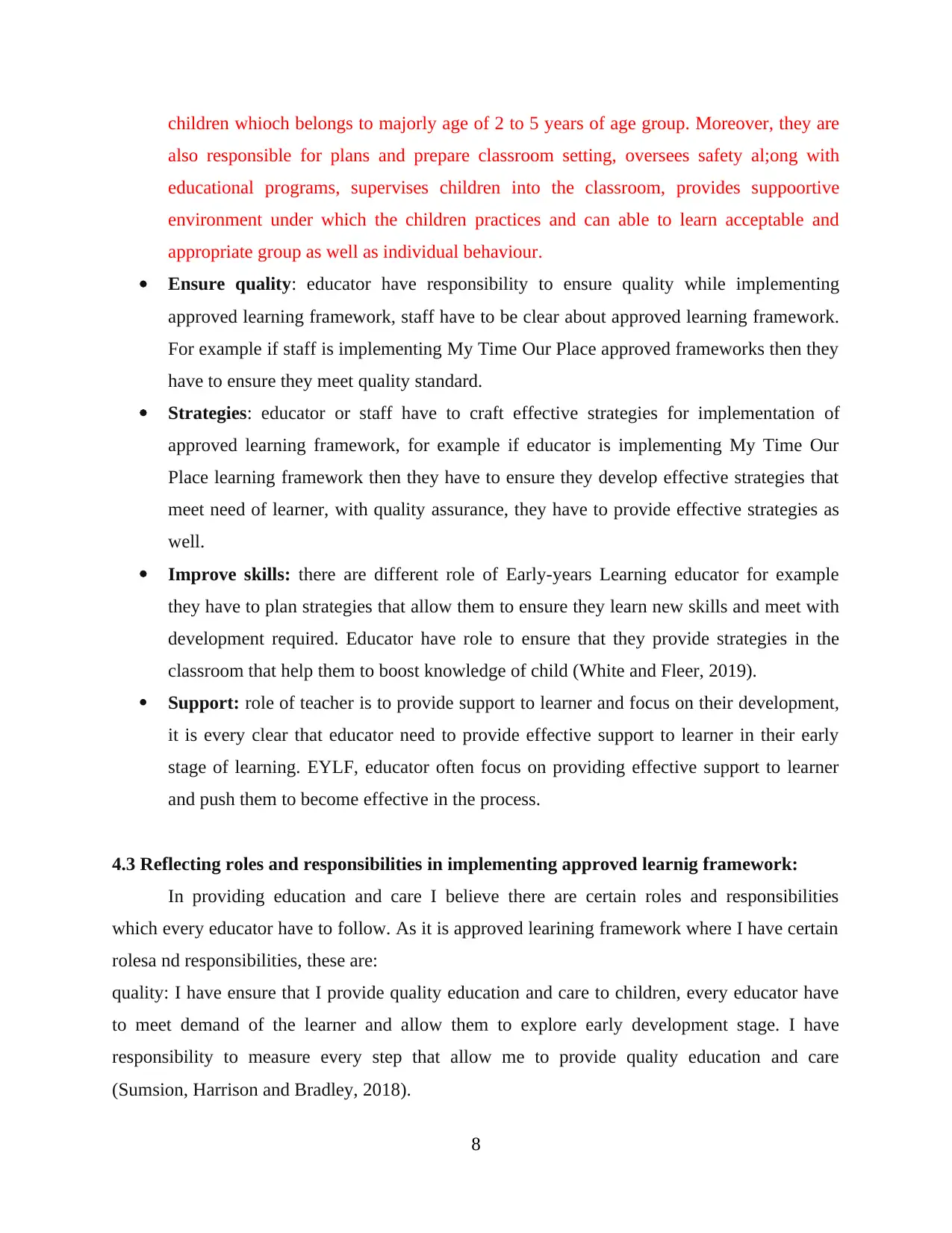
children whioch belongs to majorly age of 2 to 5 years of age group. Moreover, they are
also responsible for plans and prepare classroom setting, oversees safety al;ong with
educational programs, supervises children into the classroom, provides suppoortive
environment under which the children practices and can able to learn acceptable and
appropriate group as well as individual behaviour.
Ensure quality: educator have responsibility to ensure quality while implementing
approved learning framework, staff have to be clear about approved learning framework.
For example if staff is implementing My Time Our Place approved frameworks then they
have to ensure they meet quality standard.
Strategies: educator or staff have to craft effective strategies for implementation of
approved learning framework, for example if educator is implementing My Time Our
Place learning framework then they have to ensure they develop effective strategies that
meet need of learner, with quality assurance, they have to provide effective strategies as
well.
Improve skills: there are different role of Early-years Learning educator for example
they have to plan strategies that allow them to ensure they learn new skills and meet with
development required. Educator have role to ensure that they provide strategies in the
classroom that help them to boost knowledge of child (White and Fleer, 2019).
Support: role of teacher is to provide support to learner and focus on their development,
it is every clear that educator need to provide effective support to learner in their early
stage of learning. EYLF, educator often focus on providing effective support to learner
and push them to become effective in the process.
4.3 Reflecting roles and responsibilities in implementing approved learnig framework:
In providing education and care I believe there are certain roles and responsibilities
which every educator have to follow. As it is approved learining framework where I have certain
rolesa nd responsibilities, these are:
quality: I have ensure that I provide quality education and care to children, every educator have
to meet demand of the learner and allow them to explore early development stage. I have
responsibility to measure every step that allow me to provide quality education and care
(Sumsion, Harrison and Bradley, 2018).
8
also responsible for plans and prepare classroom setting, oversees safety al;ong with
educational programs, supervises children into the classroom, provides suppoortive
environment under which the children practices and can able to learn acceptable and
appropriate group as well as individual behaviour.
Ensure quality: educator have responsibility to ensure quality while implementing
approved learning framework, staff have to be clear about approved learning framework.
For example if staff is implementing My Time Our Place approved frameworks then they
have to ensure they meet quality standard.
Strategies: educator or staff have to craft effective strategies for implementation of
approved learning framework, for example if educator is implementing My Time Our
Place learning framework then they have to ensure they develop effective strategies that
meet need of learner, with quality assurance, they have to provide effective strategies as
well.
Improve skills: there are different role of Early-years Learning educator for example
they have to plan strategies that allow them to ensure they learn new skills and meet with
development required. Educator have role to ensure that they provide strategies in the
classroom that help them to boost knowledge of child (White and Fleer, 2019).
Support: role of teacher is to provide support to learner and focus on their development,
it is every clear that educator need to provide effective support to learner in their early
stage of learning. EYLF, educator often focus on providing effective support to learner
and push them to become effective in the process.
4.3 Reflecting roles and responsibilities in implementing approved learnig framework:
In providing education and care I believe there are certain roles and responsibilities
which every educator have to follow. As it is approved learining framework where I have certain
rolesa nd responsibilities, these are:
quality: I have ensure that I provide quality education and care to children, every educator have
to meet demand of the learner and allow them to explore early development stage. I have
responsibility to measure every step that allow me to provide quality education and care
(Sumsion, Harrison and Bradley, 2018).
8
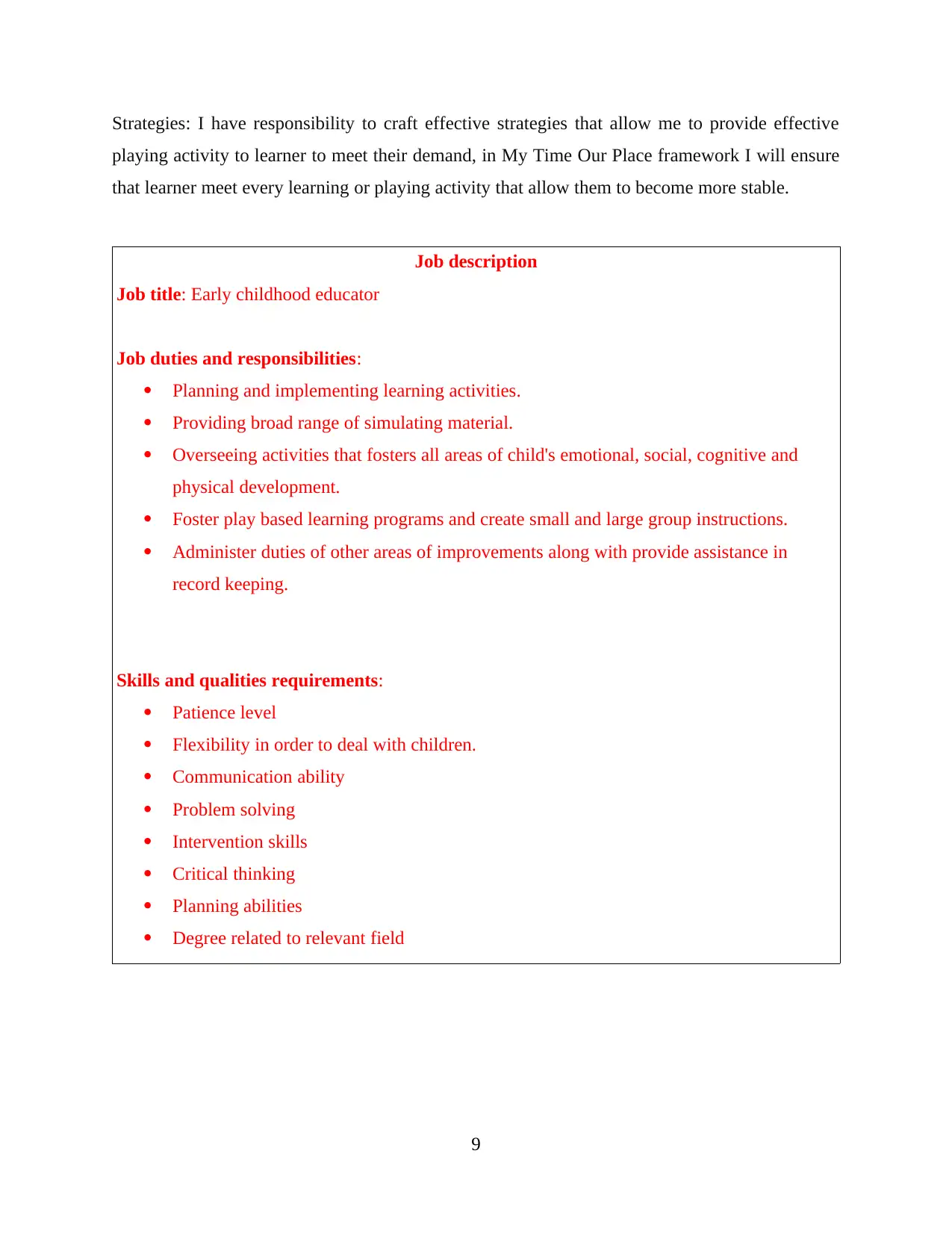
Strategies: I have responsibility to craft effective strategies that allow me to provide effective
playing activity to learner to meet their demand, in My Time Our Place framework I will ensure
that learner meet every learning or playing activity that allow them to become more stable.
Job description
Job title: Early childhood educator
Job duties and responsibilities:
Planning and implementing learning activities.
Providing broad range of simulating material.
Overseeing activities that fosters all areas of child's emotional, social, cognitive and
physical development.
Foster play based learning programs and create small and large group instructions.
Administer duties of other areas of improvements along with provide assistance in
record keeping.
Skills and qualities requirements:
Patience level
Flexibility in order to deal with children.
Communication ability
Problem solving
Intervention skills
Critical thinking
Planning abilities
Degree related to relevant field
9
playing activity to learner to meet their demand, in My Time Our Place framework I will ensure
that learner meet every learning or playing activity that allow them to become more stable.
Job description
Job title: Early childhood educator
Job duties and responsibilities:
Planning and implementing learning activities.
Providing broad range of simulating material.
Overseeing activities that fosters all areas of child's emotional, social, cognitive and
physical development.
Foster play based learning programs and create small and large group instructions.
Administer duties of other areas of improvements along with provide assistance in
record keeping.
Skills and qualities requirements:
Patience level
Flexibility in order to deal with children.
Communication ability
Problem solving
Intervention skills
Critical thinking
Planning abilities
Degree related to relevant field
9
⊘ This is a preview!⊘
Do you want full access?
Subscribe today to unlock all pages.

Trusted by 1+ million students worldwide
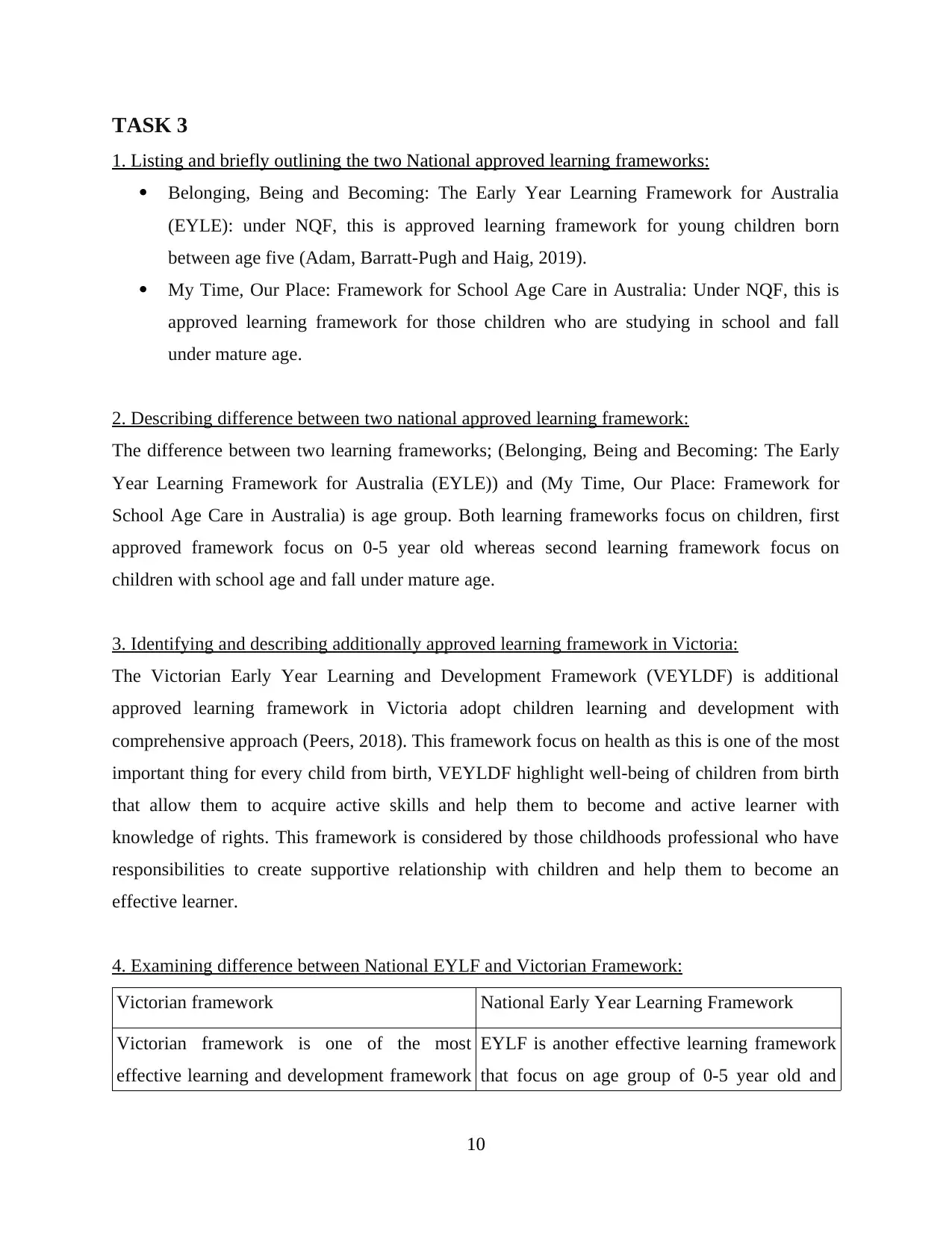
TASK 3
1. Listing and briefly outlining the two National approved learning frameworks:
Belonging, Being and Becoming: The Early Year Learning Framework for Australia
(EYLE): under NQF, this is approved learning framework for young children born
between age five (Adam, Barratt-Pugh and Haig, 2019).
My Time, Our Place: Framework for School Age Care in Australia: Under NQF, this is
approved learning framework for those children who are studying in school and fall
under mature age.
2. Describing difference between two national approved learning framework:
The difference between two learning frameworks; (Belonging, Being and Becoming: The Early
Year Learning Framework for Australia (EYLE)) and (My Time, Our Place: Framework for
School Age Care in Australia) is age group. Both learning frameworks focus on children, first
approved framework focus on 0-5 year old whereas second learning framework focus on
children with school age and fall under mature age.
3. Identifying and describing additionally approved learning framework in Victoria:
The Victorian Early Year Learning and Development Framework (VEYLDF) is additional
approved learning framework in Victoria adopt children learning and development with
comprehensive approach (Peers, 2018). This framework focus on health as this is one of the most
important thing for every child from birth, VEYLDF highlight well-being of children from birth
that allow them to acquire active skills and help them to become and active learner with
knowledge of rights. This framework is considered by those childhoods professional who have
responsibilities to create supportive relationship with children and help them to become an
effective learner.
4. Examining difference between National EYLF and Victorian Framework:
Victorian framework National Early Year Learning Framework
Victorian framework is one of the most
effective learning and development framework
EYLF is another effective learning framework
that focus on age group of 0-5 year old and
10
1. Listing and briefly outlining the two National approved learning frameworks:
Belonging, Being and Becoming: The Early Year Learning Framework for Australia
(EYLE): under NQF, this is approved learning framework for young children born
between age five (Adam, Barratt-Pugh and Haig, 2019).
My Time, Our Place: Framework for School Age Care in Australia: Under NQF, this is
approved learning framework for those children who are studying in school and fall
under mature age.
2. Describing difference between two national approved learning framework:
The difference between two learning frameworks; (Belonging, Being and Becoming: The Early
Year Learning Framework for Australia (EYLE)) and (My Time, Our Place: Framework for
School Age Care in Australia) is age group. Both learning frameworks focus on children, first
approved framework focus on 0-5 year old whereas second learning framework focus on
children with school age and fall under mature age.
3. Identifying and describing additionally approved learning framework in Victoria:
The Victorian Early Year Learning and Development Framework (VEYLDF) is additional
approved learning framework in Victoria adopt children learning and development with
comprehensive approach (Peers, 2018). This framework focus on health as this is one of the most
important thing for every child from birth, VEYLDF highlight well-being of children from birth
that allow them to acquire active skills and help them to become and active learner with
knowledge of rights. This framework is considered by those childhoods professional who have
responsibilities to create supportive relationship with children and help them to become an
effective learner.
4. Examining difference between National EYLF and Victorian Framework:
Victorian framework National Early Year Learning Framework
Victorian framework is one of the most
effective learning and development framework
EYLF is another effective learning framework
that focus on age group of 0-5 year old and
10
Paraphrase This Document
Need a fresh take? Get an instant paraphrase of this document with our AI Paraphraser
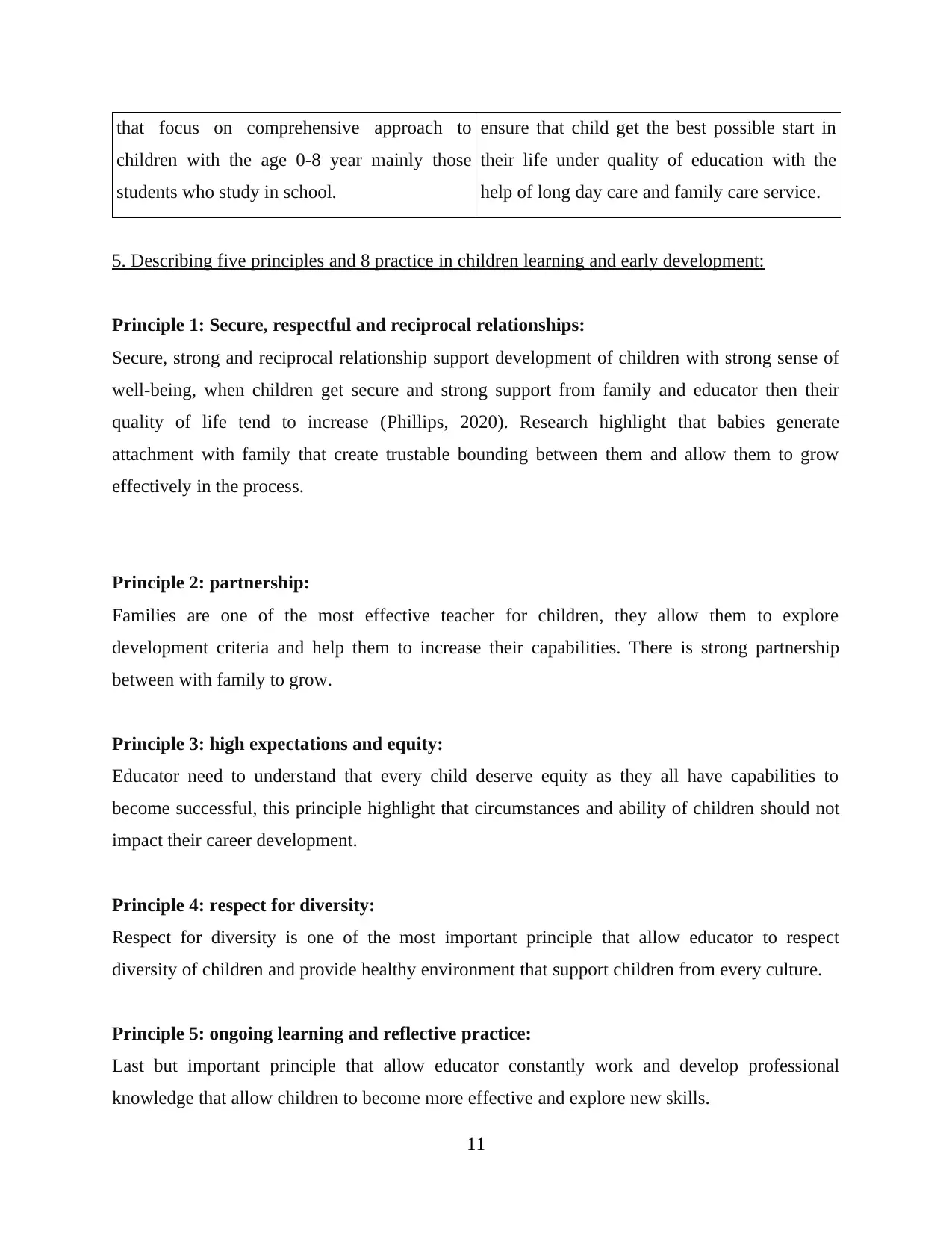
that focus on comprehensive approach to
children with the age 0-8 year mainly those
students who study in school.
ensure that child get the best possible start in
their life under quality of education with the
help of long day care and family care service.
5. Describing five principles and 8 practice in children learning and early development:
Principle 1: Secure, respectful and reciprocal relationships:
Secure, strong and reciprocal relationship support development of children with strong sense of
well-being, when children get secure and strong support from family and educator then their
quality of life tend to increase (Phillips, 2020). Research highlight that babies generate
attachment with family that create trustable bounding between them and allow them to grow
effectively in the process.
Principle 2: partnership:
Families are one of the most effective teacher for children, they allow them to explore
development criteria and help them to increase their capabilities. There is strong partnership
between with family to grow.
Principle 3: high expectations and equity:
Educator need to understand that every child deserve equity as they all have capabilities to
become successful, this principle highlight that circumstances and ability of children should not
impact their career development.
Principle 4: respect for diversity:
Respect for diversity is one of the most important principle that allow educator to respect
diversity of children and provide healthy environment that support children from every culture.
Principle 5: ongoing learning and reflective practice:
Last but important principle that allow educator constantly work and develop professional
knowledge that allow children to become more effective and explore new skills.
11
children with the age 0-8 year mainly those
students who study in school.
ensure that child get the best possible start in
their life under quality of education with the
help of long day care and family care service.
5. Describing five principles and 8 practice in children learning and early development:
Principle 1: Secure, respectful and reciprocal relationships:
Secure, strong and reciprocal relationship support development of children with strong sense of
well-being, when children get secure and strong support from family and educator then their
quality of life tend to increase (Phillips, 2020). Research highlight that babies generate
attachment with family that create trustable bounding between them and allow them to grow
effectively in the process.
Principle 2: partnership:
Families are one of the most effective teacher for children, they allow them to explore
development criteria and help them to increase their capabilities. There is strong partnership
between with family to grow.
Principle 3: high expectations and equity:
Educator need to understand that every child deserve equity as they all have capabilities to
become successful, this principle highlight that circumstances and ability of children should not
impact their career development.
Principle 4: respect for diversity:
Respect for diversity is one of the most important principle that allow educator to respect
diversity of children and provide healthy environment that support children from every culture.
Principle 5: ongoing learning and reflective practice:
Last but important principle that allow educator constantly work and develop professional
knowledge that allow children to become more effective and explore new skills.
11
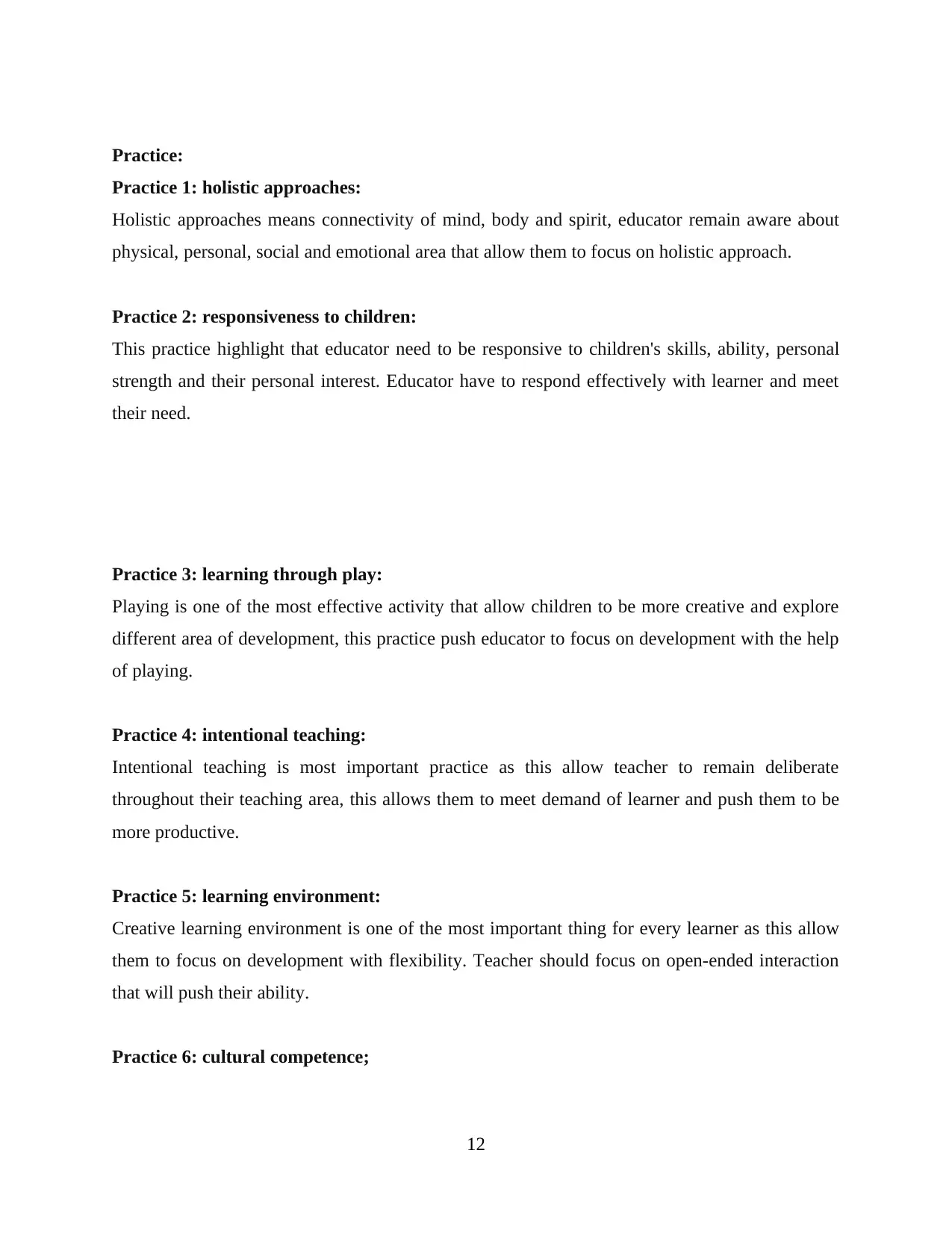
Practice:
Practice 1: holistic approaches:
Holistic approaches means connectivity of mind, body and spirit, educator remain aware about
physical, personal, social and emotional area that allow them to focus on holistic approach.
Practice 2: responsiveness to children:
This practice highlight that educator need to be responsive to children's skills, ability, personal
strength and their personal interest. Educator have to respond effectively with learner and meet
their need.
Practice 3: learning through play:
Playing is one of the most effective activity that allow children to be more creative and explore
different area of development, this practice push educator to focus on development with the help
of playing.
Practice 4: intentional teaching:
Intentional teaching is most important practice as this allow teacher to remain deliberate
throughout their teaching area, this allows them to meet demand of learner and push them to be
more productive.
Practice 5: learning environment:
Creative learning environment is one of the most important thing for every learner as this allow
them to focus on development with flexibility. Teacher should focus on open-ended interaction
that will push their ability.
Practice 6: cultural competence;
12
Practice 1: holistic approaches:
Holistic approaches means connectivity of mind, body and spirit, educator remain aware about
physical, personal, social and emotional area that allow them to focus on holistic approach.
Practice 2: responsiveness to children:
This practice highlight that educator need to be responsive to children's skills, ability, personal
strength and their personal interest. Educator have to respond effectively with learner and meet
their need.
Practice 3: learning through play:
Playing is one of the most effective activity that allow children to be more creative and explore
different area of development, this practice push educator to focus on development with the help
of playing.
Practice 4: intentional teaching:
Intentional teaching is most important practice as this allow teacher to remain deliberate
throughout their teaching area, this allows them to meet demand of learner and push them to be
more productive.
Practice 5: learning environment:
Creative learning environment is one of the most important thing for every learner as this allow
them to focus on development with flexibility. Teacher should focus on open-ended interaction
that will push their ability.
Practice 6: cultural competence;
12
⊘ This is a preview!⊘
Do you want full access?
Subscribe today to unlock all pages.

Trusted by 1+ million students worldwide
1 out of 15
Related Documents
Your All-in-One AI-Powered Toolkit for Academic Success.
+13062052269
info@desklib.com
Available 24*7 on WhatsApp / Email
![[object Object]](/_next/static/media/star-bottom.7253800d.svg)
Unlock your academic potential
Copyright © 2020–2025 A2Z Services. All Rights Reserved. Developed and managed by ZUCOL.





